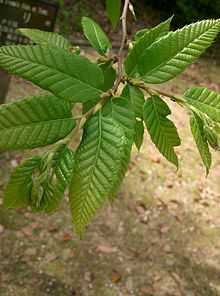Castanea crenata
| Japanese chestnut | |
|---|---|
 | |
| Scientific classification | |
| Kingdom: | Plantae |
| (unranked): | Angiosperms |
| (unranked): | Eudicots |
| (unranked): | Rosids |
| Order: | Fagales |
| Family: | Fagaceae |
| Genus: | Castanea |
| Species: | C. crenata |
| Binomial name | |
| Castanea crenata Siebold & Zucc. | |
Castanea crenata (Japanese chestnut[1]) is a species of chestnut originally native to Japan and South Korea. It is a small to medium-sized deciduous tree growing to 10-15 m tall. The leaves are similar to those of the sweet chestnut, though usually a little smaller, 8-19 cm long and 3-5 cm broad. The flowers of both sexes are borne in 7-20 cm long, upright catkins, the male flowers in the upper part and female flowers in the lower part. They appear in summer, and by autumn, the female flowers develop into spiny cupules containing 3-7 brownish nuts that are shed during October.
Cultivation and uses
It is an important tree in Japan for its heavy production of sweet, edible nuts. A number of cultivars have been selected for large nut size. It is also widely cultivated in eastern China and Taiwan.
It is resistant to chestnut blight, and is of importance in North America in the development of disease-resistant hybrids with the highly susceptible American chestnut.
Gallery
References
- ↑ "BSBI List 2007". Botanical Society of Britain and Ireland. Archived from the original (XLS) on 2015-02-25. Retrieved 2014-10-17.
| Wikimedia Commons has media related to Castanea crenata. |


